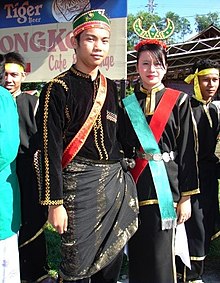 Bisaya Sabah traditional costume | |
| Total population | |
|---|---|
| c. 140,000 | |
| Regions with significant populations | |
| Languages | |
| Sabah Bisaya, Brunei Bisaya, Sabah Malay, Sarawak Malay, Brunei Malay, Standard Malay, English | |
| Religion | |
| Majority Islam (Sabah and Brunei) and significant minorities of Christianity and Animism (Sarawak) | |
| Related ethnic groups | |
| Lotud, Dusuns, Murut, Lun Bawang/Lundayeh, Kadazan-Dusun, Dayaks |
Bisaya is an indigenous people from the northwest coast of East Malaysia on the island of Borneo. Their population is concentrated around Beaufort as well as Kuala Penyu districts of southern Sabah (in which they are counted under the Kadazan-Dusun group of peoples), Labuan Federal Territory and in Limbang District, Sarawak (in which they are grouped under the Orang Ulu designation). The Bisaya tribe has many similarities with the Dusun Tatana tribe, especially in terms of language. It is evident that some of their dialogical language conversations are almost identical if they have a dialogue with each other. Nowadays the Bisaya living in Sabah are Muslims, while the Bisaya living in Sarawak are mostly Christians. In Brunei, they are referred as Dusun, Jati Dusun and Bisaya (one group with the Dusun people of Sabah, Dusunic people).[5] The Bisaya is closely related, linguistically, with the Tatana Dusun of Kuala Penyu, Sabah.
- ^ "Tutong, Bisayan in Brunei". Joshua Project. Retrieved 25 August 2015.
- ^ Raymond G. Gordon Jr., ed. (2005). Ethnologue: Languages of the World, Fifteenth edition. SIL International. ISBN 1-55671-159-X.
- ^ Project, Joshua. "Bisaya, Sabah Bisaya in Malaysia". Joshua Project. Retrieved 25 August 2015.
- ^ "Bisaya, Sabah Bisaya in United States". Joshua Project. Retrieved 25 August 2015.
- ^ Ooi, Keat Gin (2004). Southeast Asia: A Historical Encyclopedia, from Angkor Wat to East Timor. ABC-CLIO. p. 272. ISBN 978-1-57607-770-2.